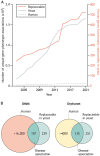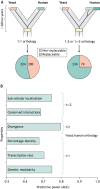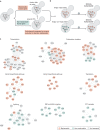Humanized yeast to model human biology, disease and evolution
- PMID: 35661208
- PMCID: PMC9194483
- DOI: 10.1242/dmm.049309
Humanized yeast to model human biology, disease and evolution
Abstract
For decades, budding yeast, a single-cellular eukaryote, has provided remarkable insights into human biology. Yeast and humans share several thousand genes despite morphological and cellular differences and over a billion years of separate evolution. These genes encode critical cellular processes, the failure of which in humans results in disease. Although recent developments in genome engineering of mammalian cells permit genetic assays in human cell lines, there is still a need to develop biological reagents to study human disease variants in a high-throughput manner. Many protein-coding human genes can successfully substitute for their yeast equivalents and sustain yeast growth, thus opening up doors for developing direct assays of human gene function in a tractable system referred to as 'humanized yeast'. Humanized yeast permits the discovery of new human biology by measuring human protein activity in a simplified organismal context. This Review summarizes recent developments showing how humanized yeast can directly assay human gene function and explore variant effects at scale. Thus, by extending the 'awesome power of yeast genetics' to study human biology, humanizing yeast reinforces the high relevance of evolutionarily distant model organisms to explore human gene evolution, function and disease.
Keywords: Functional complementation; Functional replaceability; Humanized yeast; Orthology.
© 2022. Published by The Company of Biologists Ltd.
Conflict of interest statement
Competing interests The authors declare no competing or financial interests.
Figures







Similar articles
-
Biomedical applications of yeasts - a patent view, part two: era of humanized yeasts and expanded applications.Expert Opin Ther Pat. 2020 Aug;30(8):609-631. doi: 10.1080/13543776.2020.1781816. Epub 2020 Jun 30. Expert Opin Ther Pat. 2020. PMID: 32529867 Review.
-
Efforts to make and apply humanized yeast.Brief Funct Genomics. 2016 Mar;15(2):155-63. doi: 10.1093/bfgp/elv041. Epub 2015 Oct 13. Brief Funct Genomics. 2016. PMID: 26462863 Free PMC article. Review.
-
From yeast to patient neurons and back again: powerful new discovery platform.Mov Disord. 2014 Sep;29(10):1231-40. doi: 10.1002/mds.25989. Epub 2014 Aug 14. Mov Disord. 2014. PMID: 25131316
-
CRIMEtoYHU: a new web tool to develop yeast-based functional assays for characterizing cancer-associated missense variants.FEMS Yeast Res. 2017 Dec 1;17(8). doi: 10.1093/femsyr/fox078. FEMS Yeast Res. 2017. PMID: 29069390
-
Synthetic genome engineering forging new frontiers for wine yeast.Crit Rev Biotechnol. 2017 Feb;37(1):112-136. doi: 10.1080/07388551.2016.1214945. Epub 2016 Aug 18. Crit Rev Biotechnol. 2017. PMID: 27535766 Review.
Cited by
-
Humanization reveals pervasive incompatibility of yeast and human kinetochore components.G3 (Bethesda). 2023 Dec 29;14(1):jkad260. doi: 10.1093/g3journal/jkad260. G3 (Bethesda). 2023. PMID: 37962556 Free PMC article.
-
Thanksgiving to Yeast, the HMGB Proteins History from Yeast to Cancer.Microorganisms. 2023 Apr 11;11(4):993. doi: 10.3390/microorganisms11040993. Microorganisms. 2023. PMID: 37110415 Free PMC article. Review.
-
Sharing resources to advance translational research.Dis Model Mech. 2022 Oct 1;15(10):dmm049944. doi: 10.1242/dmm.049944. Epub 2022 Oct 31. Dis Model Mech. 2022. PMID: 36314583 Free PMC article.
-
Homo cerevisiae-Leveraging Yeast for Investigating Protein-Protein Interactions and Their Role in Human Disease.Int J Mol Sci. 2023 May 24;24(11):9179. doi: 10.3390/ijms24119179. Int J Mol Sci. 2023. PMID: 37298131 Free PMC article. Review.
-
Generating combinatorial diversity via engineered V(D)J-like recombination in Saccharomyces cerevisiae.Nat Commun. 2025 Jul 1;16(1):5688. doi: 10.1038/s41467-025-61206-1. Nat Commun. 2025. PMID: 40592886 Free PMC article.
References
-
- 1000 Genomes Project Consortium, Auton, A., Brooks, L. D., Durbin, R. M., Garrison, E. P., Kang, H. M., Korbel, J. O., Marchini, J. L., McCarthy, S., McVean, G. A., and Abecasis, G. R. (2015). A global reference for human genetic variation. Nature 526, 68-74. 10.1038/nature15393 - DOI - PMC - PubMed
-
- Ahn, J., Choi, C.-H., Kang, C.-M., Kim, C.-H., Park, H.-M., Song, K.-B., Hoe, K.-L., Won, M. and Chung, K.-S. (2009). Generation of expression vectors for high-throughput functional analysis of target genes in Schizosaccharomyces pombe. J. Microbiol. 47, 789-795. 10.1007/s12275-009-0010-4 - DOI - PubMed
-
- Aiyar, R. S., Bohnert, M., Duvezin-Caubet, S., Voisset, C., Gagneur, J., Fritsch, E. S., Couplan, E., von der Malsburg, K., Funaya, C., Soubigou, F.et al. (2014). Mitochondrial protein sorting as a therapeutic target for ATP synthase disorders. Nat. Commun. 5, 5585. 10.1038/ncomms6585 - DOI - PMC - PubMed
Publication types
MeSH terms
Substances
LinkOut - more resources
Full Text Sources
Molecular Biology Databases

